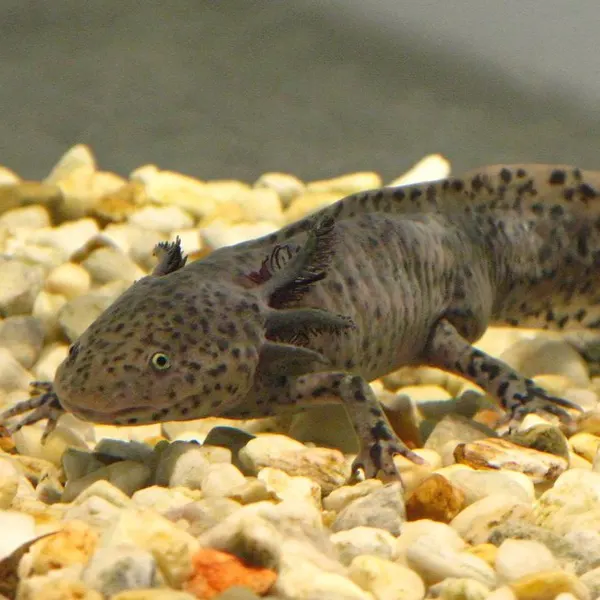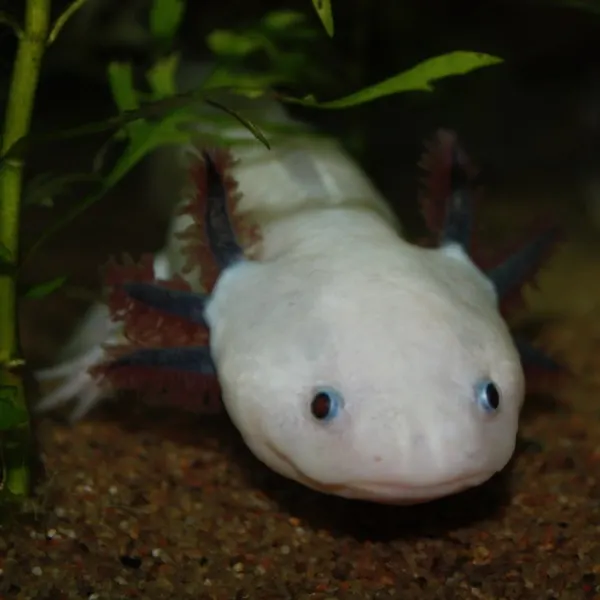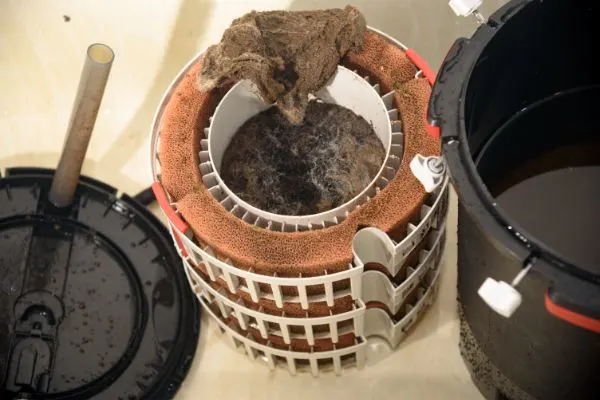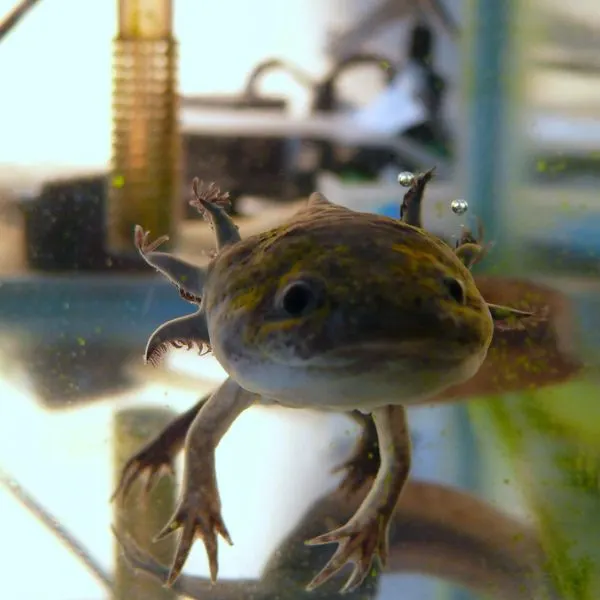If you are thinking of getting an axolotl as a pet, you should know that they require pristine water to stay healthy and live a long life. A good aquarium filter will make your life so much easier, but with all the choices out there, what is the best filter for an axolotl tank?
With their constant smile and the bright red frills waving at you, axolotls are one of the cutest pets out there. But they need that cuteness to counteract the extreme sensitivity these animals come with.
If you’re in a hurry, here’s our top pick. The size of the filter you choose will vary depending on your tank size. A quick rule of thumb for flow should be 3 times your tank size.
If you have more time, read the full guide to learn how to choose the right filter for your setup.
Table of Contents
Aquatic Baby Dinosaur

Going back in time almost 30 years ago, while walking in the mall, I came across this vendor that had these exotic water creatures I had never seen before. Curiosity had me by the throat and I had to gaze at these strange, smiling, throwbacks from the land that time forgot.
The man seemed a bit sketchy, and I wanted to walk away, but these salamander-looking things with feathery frills behind their heads were beyond intriguing.
To shorten this story, I ended up walking away with an axolotl (the vendor called it a baby, aquatic, living dinosaur. My inner child couldn’t walk away without one).
There were only a few instructions with this one, and they were all wrong. I didn’t know at the time because there was no information on the budding new technology called the internet, and I didn’t even have the real name of the creature.
Needless to say, unfortunately, it died after a few short months. So, when I actually found out the true name of these creatures, as they started becoming popular in everyday homes, I devoured as much information as I could about them.
This experience highlighted the importance of biological filtration in maintaining a healthy axolotl environment.
Aquarium Owner For Many Years
Soon after that mishap, I took my aquarium, cleaned it really well, and started keeping fish. I kept many different fish for many years and have a lot of experience in filters, substrate, water conditioning, and everything that goes along with keeping fish alive and healthy.
For tropical fish, water quality is extremely important, but it’s even more paramount for the sensitive axolotl. The right filter will be one of the most important pieces of equipment you buy for your axolotl, but you can’t just walk into a pet store and buy the first thing you see.
About Axolotls

One of the reasons the water needs to be so clean is because of the way they eat. Axolotls use suction to pull food into their mouths.
They inevitably swallow water when they eat, so if there are any parasites, a lot of bacteria, or anything that can make them sick floating in the water, they can accidentally ingest it.
Axolotls are messy eaters, and their food, especially when they are young, is messy. When axies are very small, they need live food to eat like brine shrimp, daphnia, or black worms.
Live brine shrimp live in saltwater, your axie lives in freshwater, so when you drop live brine shrimp in, they will die very soon. Whatever your axie doesn’t eat can start to rot and throw the water balance off. So they need to be removed soon after feeding.
Daphnia can live in freshwater, so they aren’t as messy, but if they die in the water, you have the same issue.
Worms for little axies are messy because since axolotls can’t chew their food, these worms need to be cut into smaller pieces for them to consume. Worm guts and parts floating around in the water aren’t good either, creating a lot of waste that requires efficient filtration, so you’ll need a really good filter to clean that up.
Poor water quality can be particularly harmful to axolotls, underscoring the need for a reliable filtration system.
What About Live Tank Cleaners?

One thing I like about tropical fish is you can get tankmates that help to keep your aquarium clean. Algae eaters scour the bottom of the tank for leftover food bits and algae on surfaces, while the “suckerfish” or plecos help to keep the glass and other surfaces free of green slime.
There are also scavengers like shrimp that can help to keep the tank clean too, but you can’t put these fish into tanks with axolotls. If the fish are smaller, the axie will most likely try to eat them.
Plecos can also latch onto your axie and damage the slime coat and sensitive skin of the axolotl. Temperature is another factor because axolotls like cooler water, whereas tropical fish like algae eaters and plecos thrive better in warm, tropical waters that are dangerous for an axie.
With all that being said, the best cleaners for axolotls are great filters and active owners.
What Filters Work Best For Axolotls?

There are several types of filters out there. Then when you start getting into brands, it can become even more confusing.
It’s worth noting that while power filters are effective, they are not always the best choice for axolotl tanks due to their high flow rate.
Breaking it down, axolotls need a filter that first and foremost cleans the water exceptionally well. It also needs to either create a low flow or have some apparatus that reduces water flow.
Axolotls can get stressed out if they are constantly having to fight against a current. They like to hang out at the bottom of the tank most of the time and leisurely walk around. They won’t do well if they have to expend a lot of energy in heavy currents.
Though HOB filters are popular, they aren’t suitable for axolotl tanks due to the strong currents they create. Additionally, over-the-top filters aren’t recommended, and if you’re getting a high-flow filter, you’ll need to make sure you have an adjustable output or a spray bar. Some filters come with a spray bar which helps to lessen the current.
These requirements narrow down the list considerably, leaving sponge filters and canister filters in the running. Under-gravel filters are not recommended for axolotl tanks due to their disruption of the substrate.
It’s a good idea to consider these factors when choosing the right filter for your axolotl tank.
What’s The Difference Between Canister And Sponge Filters?
Sponge filters work with an air pump to filter water through sponges. These aquarium filters trap larger particulates that don’t have a lot of parts to keep clean and make no noise. The only noise will come from the air pump.
They work great and are a very economical product. Your pet’s aquarium filter also shouldn’t create a lot of currents, so they are safe for smaller live prey if that’s what you are feeding your axolotls, and your axies won’t be stressed by too much current.
Sponge filters are an easy filter for beginners and would be a good option if you are only planning on keeping one axolotl in a smaller tank. Sponge filters can work if you are always on top of keeping the tank clean.
This means removing any loose food your axolotl does not eat, cleaning up any poop as soon as you see it, and doing regular, partial water changes.
For small tanks, a sponge filter might suffice, but it requires diligent maintenance.
Canister Filters

Canister filters are bigger, have more parts, and will require biomedia, and of course, they are more expensive, but they come with a host of benefits.
For one, a canister filter will keep your water cleaner than any other type of filter. This makes them ideal for large tanks or larger tanks where maintaining water quality is more challenging. And the cleaner the water for your axie, the more likely they will remain happy and healthy.
Canister filters work by pulling dirty water out of the tank, down into the canister, and through several layers of filtering media, then it pumps the clean water back into the tank. These filters often filter a lot of water in a short amount of time.
Additionally, the chemical filtration process in canister filters is essential for removing harmful toxins from the tank.
You’ll need a filter that cycles three times the amount of water that your tank holds per hour. For example, if you have a 20-gallon fish tank, you need a canister that will cycle at least 60 gallons per hour. Always choose a filter appropriate for the size of the tank to ensure efficient water filtration.
Therefore, a canister filter is often the best option for ensuring the highest water quality.
Canisters Are Customizable

Canister filters have different chambers inside them that can hold different media.
Typically, they will contain a poly-mesh or sponge filter material, carbon, and a coarse filter biomedia. You can use different types of media to best suit your tank. The mechanical filtration stage is crucial for physically removing debris from the tank.
For even more filtration, or if you just aren’t able to clean the tank as often as you should, you can even attach a sponge filter to the lines of the canister filter.
The sponge filter will trap bigger particles, leaving the smallest stuff for the canister filter. This can also save how often you need to clean the canister, but you still have to clean the sponge filter, so it basically evens out there.
Canister filters help to keep the correct balance of good bacteria in the tank. With biomedia, as the water filters through it helps to produce beneficial bacteria that keep the tank healthy and balanced.
This bacteria removes ammonia and nitrates which when they get too high can be fatal for fish and especially axolotls.
Another plus for the canister filter is they usually have an adjustable flow control and/or a spray bar that cuts down on excess water current. If you find your axie struggling with the water flow, you can slow it down or install the spray bar which spreads out the output of the clean water.
Canister Filter Cons
The canister filter comes in for the win, but that doesn’t mean they are a flawless, clean sweep. They do come with a few cons.
Canister filters are expensive. Because of the multiple filter chambers, the high output, and their design, these filters are usually the most expensive type of filter. But for the price, you get the cleanest water, and for axolotls, that is what’s most important.
Cleaning them can be a pain. You have multiple chambers that need to be cleaned, and the charcoal and biomedia need to be replaced on occasion. Carbon helps to remove chlorine and harmful organic materials from the water.
They can create high flow. Canister filters are powerful, and they can create fast currents. That’s why they often come with spray bars.
Some people position plants around the output or direct the flow to the back of the tank or corner to reduce the flow.
Canister Filters Are The Way To Go

Even with the cons to these filters, you simply can’t beat how good they are for axolotl health and keeping the water as clean as possible. You will have to experiment and keep an eye on your pet and the tank for a little while to make sure everything is working best for your pet.
That means adjusting the flow to make sure the current isn’t too strong. As well as making sure the filter is keeping the water as clean as it possibly can.
One word of advice, if you are just setting up a new tank with a new filter, you should run the filter for about two weeks without any animals in there. This helps to equalize the water and create a good buildup of beneficial bacteria.
Let’s Touch On Biomedia
What exactly is biomedia? It’s a porous material that lets beneficial bacteria form colonies inside a filter. As the “dirty” water flows over the biomedia and the bacterial colonies they remove harmful ammonia and nitrates.
This biological media is essential for fostering beneficial bacteria that aid in the nitrogen cycle.
There are many different types of biomedia available, but the main thing to look out for when purchasing is the size of the particles. It needs to fit in your size filter. Smaller pellets will work better with smaller filter chambers.
A great, high-quality biomedia for canister filters is this Fluval Biological Filter Media. It’s small enough to fit into smaller chambers, and because it’s made of ceramic it will last much longer than sponges.
Should Biomedia Be Cleaned Or Changed?
Biomedia does need to be changed occasionally, but not completely. You don’t want to completely remove all the beneficial bacteria that has built up over time.
Some manufacturers recommend replacing about half our biomedia every 6 months or so. The pores eventually clog up with “crud” and can’t be cleaned out.
Replacing half the media every six months keeps the beneficial bacteria growth and keeps the biomedia clean.
When you are cleaning your tank and filter, just rinse off the biomedia with water that was removed for the water change. You don’t want to clean off all the bacteria that took weeks to build up.
That’s all the cleaning biomedia needs unless it’s truly very dirty. If that is the case, you should replace the pellets, but again, you’ll need to let it run for about two weeks to build up a good colony.
Is Biomedia Really Necessary?
This is recommended in most aquariums to help keep the water balanced by removing harmful ammonia. Axolotls are more sensitive to water changes and water balance than most fish are, so having an extra layer to help keep the water as clean as possible is in my opinion, very necessary.
How Often Should You Clean The Filter?

Canister filters can typically go the longest between cleanings. A sponge filter needs to be cleaned weekly or once every two weeks, but your canister can go about three to four months before needing a deep clean.
At this time, you’ll need to replace the filter media and clean out any rotting debris or algae. When cleaning a canister, you have to be careful how you clean it because you don’t want to kill off the beneficial, ammonia-neutralizing bacteria.
That means no hot water, no soap, and definitely no bleach or disinfecting agents.
To clean the media chambers, use a soft bristle brush and clean water, or aquarium water that’s being removed when you do a partial tank change. Soaps, hot water, and bleach will destroy the beneficial bacteria in the filter.
Use the removed aquarium water to rinse off the biomedia as well. Again, just to clean off some of the debris, not the bacteria colonies.
What Is The Best Filter?
For an axolotl tank, the best filter, especially when starting out, will be this Penn-Plax Cascade Canister Filter for Large Aquariums and Fish Tanks from 30 to 200 Gallons. This brand has several sizes for whatever tank size you have.
For the safety of your pets, this brand has a flow valve control on all sizes, and a spray bar, so you can adjust how much water pressure comes out of the pump hose. The smaller sizes have two to three filter chambers, but they all come with charcoal, filters, and coarse biomedia sponges.
The biomedia sponges do the same thing as biomedia pellets, but they don’t last as long.
Honorable Mentions For Those Who Want Options
Fluval 07 Series Performance Canister Filter. If you’ve ever owned an aquarium, you have probably heard of Fluval. They have been in the filter business for several years, and their name has become synonymous with quality.
The Fluval 07 Series are great filters. This particular filter cycles 95 gallons per hour, so it is great for 20 to 30-gallon tanks. It comes with everything to get started except a spray bar.
If you’re looking to purchase this filter, I suggest adding a Spray Bar to the cart so that you don’t send your axie into white water rapids with this filter.
Marineland Magniflow Canister Filter for Aquariums has four stages of filtration, leaving your tank crystal clear. It has a typical mesh filter, carbon filter to get rid of odors, biomedia for beneficial bacteria, and a water polishing pad that is useful for removing the smallest of particles.
It also comes with a spray bar and is gentle enough for axolotls. The cons on the other hand are that this thing needs to be cleaned about every three weeks, and it’s difficult—to say the least—to put together and get running. Depending on your experience with canister filters, this one may take an hour or longer to get running properly.
The last runner-up is by no means the lowest contender on the list. It would actually be on the top, aside from the price. This one is the priciest of the bunch, but there’s a reason.
The SunSun Hw303B 370GPH Pro Canister Filter Kit has 5 stages of filtration. It has four trays to hold filters and biomedia, but the fifth is a UV light built into the pump that kills off algae and harmful bacteria.
It’s easier to set up and won’t take nearly as long as the Marineland Magniflow filter and is much easier to take apart and clean. If you have the extra money, I’d say go with the SunSun and you won’t be disappointed.
The SunSun filter comes with plenty of biomedia options included in the package. So it might actually be worth it in the long run.
Keep The Water Clean, But Also Cool

Another very important factor about axolotls and their environment, they need cool water to stay healthy. This can be achieved in a couple of ways.
- Keeping the room cool where your axie is staying is one way.
- Don’t put the tank in direct sunlight
- Use an aquarium water chiller
- Get an aquarium fan
Aquarium water chillers work like air conditioners. They use condensed liquid that runs through coils to cool the water from the aquarium off. They work great to keep the water very cool, but they can get very expensive.
A more economical way to keep your axolotl’s tank cool is by using an aquarium fan. These sit at the top of the aquarium and blow over the top of the water. They can cool the water down by a few degrees which is great if the room tends to stay a bit warm.
JANNIDE Aquarium Chillers Cooling Fan has three, adjustable fan heads, with two speeds. This fan can keep the water 2 to 4 degrees cooler than without it.
FAQs
Do axolotls need bubblers?
The short answer is no, axolotls do not need air bubblers for extra oxygen.
Axolotls have three ways they can breathe. The external gills are their main way of getting oxygen, they can also absorb some oxygen through their skin as all amphibians do, and they have a set of rudimentary lungs.
You may see your axie swimming to the top of the tank and gulping air which is normal behavior. The tank filter helps to agitate the water enough to add oxygen to the water, plus axolotls like cooler water temperatures.
Cooler water holds onto oxygen longer and can have a higher concentration of oxygen, so again, an air bubbler is not required for axolotl tanks.
Is a sponge filter enough for an axolotl tank?
Yes, a sponge filter is plenty enough filtration for an axolotl tank. Provided you are very fastidious about keeping the tank clean and doing regular cleanings on your sponge filter.
A sponge filter doesn’t provide as much filtration as a canister, and so it needs to be cleaned at least once a week. On top of that, you will have to constantly remove uneaten food, debris and axie poop every day to keep the water clean and balanced enough.
With just a sponge filter, it’s recommended to check ammonia and nitrite levels in the water frequently to make sure they don’t get too high and cause illness to your pets. You’ll also have to perform partial water changes more often with just a sponge filter.
Do axolotls require a filter?
No, axolotls don’t absolutely need a filter, but if you want to make your life easier and have a healthier pet, we strongly recommend you get a good quality filter.
Axolotls need pristine, clean water to stay healthy. Unfiltered, unchanged water can quickly accumulate a lot of ammonia which can be fatal to axies. If you are going sans filter, you will have to perform water changes frequently, which can also lead to undue stress on the animal.
If cost is the main issue, sponge filters are a great way to go. They are inexpensive, only require an air pump to run them and they clean the water very well. You’ll have to clean them more often, but a cheap filter is way better than no filter at all.
The Verdict
Axolotls and their popularity are constantly on the rise. They are some of the cutest pets you can own, but you have to be a dedicated pet owner.
Axolotls are quite sensitive to their environment, and if you’re not willing to put in the time and energy for exquisite tank cleaning, you’d probably be better off with another pet that is more forgiving.
Red ear sliders, frogs, or toads are easier pets to manage if you really want an amphibious pet that is more challenging than fish, but not as intense of a commitment as an axolotl.
To really keep your tank clean, and ammonia levels down, and reduce the time you’ll spend on tank maintenance, a canister filter is your best bet. They are expensive, but they are definitely worth their cost.
With a canister filter, you won’t have to clean the tanks as often, and they will help to increase the health of your pet.
More Axolotl stuff
